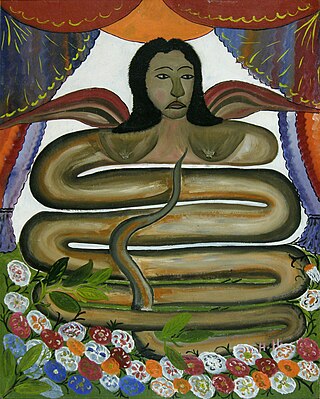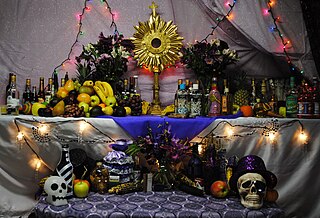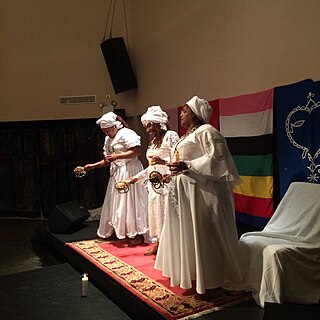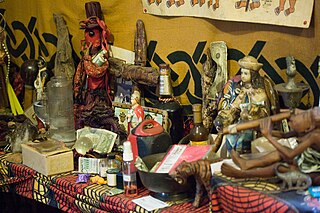
Lwa, also called loa, are spirits in the African diasporic religion of Haitian Vodou. They have also been incorporated into some revivalist forms of Louisiana Voodoo. Many of the lwa derive their identities in part from deities venerated in the traditional religions of West Africa, especially those of the Fon and Yoruba.

Vodun is a religion practiced by the Aja, Ewe, and Fon peoples of Benin, Togo, Ghana, and Nigeria.

Damballa, also spelled Damballah, Dambala, Dambalah, among other variations, is one of the most important of all loa, spirits in Haitian Voodoo and other African diaspora religious traditions such as Obeah. He is traditionally portrayed as a great white or black serpent, but may also be depicted as a rainbow. Damballa originated in the city of Wedo in modern-day Benin.

Papa Legba is a lwa in Haitian Vodou, Dominican Vodou, Winti and Louisiana Voodoo, who serves as the intermediary between God and humanity. He stands at a spiritual crossroads and gives permission to speak with the spirits of Guineé, and is believed to speak all human languages. In Haiti, he is the great elocutioner. Legba facilitates communication, speech, and understanding. He is commonly associated with dogs. Papa Legba is invoked at the beginning of every ceremony. Papa Legba has his origins in the historic West African kingdom of Dahomey, located within present-day Benin.

Oungan is the term for a male priest in Haitian Vodou. The term is derived from Gbe languages. The word hounnongan means chief priest. ‘'Hounnongan or oungans are also known as makandals.

The term Voodoo doll commonly refers to an effigy that is typically used for the insertion of pins. Such practices are found in various forms in the magical traditions of many cultures around the world.

Homosexuality in Haitian Vodou is religiously acceptable and homosexuals are allowed to participate in all religious activities. However, in West African countries with major conservative Christian and Islamic views on LGBTQ people, the attitudes towards them may be less tolerant if not openly hostile and these influences are reflected in African diaspora religions following Atlantic slave trade which includes Haitian Vodou.
A bokor (male) or caplata (female) is a Vodou priest or priestess for hire in Haiti who is said to serve the loa, "'with both hands', practicing for both good and evil." Their practice includes the creation of zombies and of ouangas.

A manbo is a priestess in the Haitian Vodou religion. Haitian Vodou's conceptions of priesthood stem from the religious traditions of enslaved people from Dahomey, in what is today Benin. For instance, the term manbo derives from the Fon word nanbo. Like their West African counterparts, Haitian manbos are female leaders in Vodou temples who perform healing work and guide others during complex rituals. This form of female leadership is prevalent in urban centers such as Port-au-Prince. Typically, there is no hierarchy among manbos and oungans. These priestesses and priests serve as the heads of autonomous religious groups and exert their authority over the devotees or spiritual servants in their hounfo (temples).

Haitian Vodou is an African diasporic religion that developed in Haiti between the 16th and 19th centuries. It arose through a process of syncretism between several traditional religions of West and Central Africa and Roman Catholicism. There is no central authority in control of the religion and much diversity exists among practitioners, who are known as Vodouists, Vodouisants, or Serviteurs.
Louis Martinié is an author, "internationally known" percussionist, practitioner of a multitude of religions among them being New Orleans style Voodoo, and co-author of the book New Orleans VooDoo Tarot (1992), with Sallie Ann Glassman.
Hexing a Hurricane is a 2006 documentary film about the effect of Hurricane Katrina on New Orleans. It has been billed as the "First Katrina documentary" released by a New Orleanian. The film was directed by Jeremy Campbell and distributed by the National Film Network. The film's score was orchestrated by New Orleans artist Eric Laws.

Louisiana Voodoo, also known as New Orleans Voodoo, is an African diasporic religion that originated in Louisiana. It arose through a process of syncretism between the traditional religions of West Africa, the Roman Catholic form of Christianity, and Haitian Vodou. No central authority is in control of Louisiana Voodoo, which is organized through autonomous groups.
Vodou drumming and associated ceremonies are folk ritual faith system of henotheistic religion of Haitian Vodou originated and inextricable part of Haitian culture.

Christian-Vodou can be seen as a syncretism of different cultures and religions. Primarily focused on Haitian Vodou and Catholic Christianity, the two have been merging together in a way since around the 18th century, when a majority of Haiti was part of the Atlantic slave trade.
Marie Thérèse Alourdes Macena Champagne Lovinski (1933–2020), also known by the name Mama Lola, was a Haitian-born manbo (priestess) in the African diasporic religion of Haitian Vodou. She had lived in the United States since 1963.
Myrlande Constant is a Haitian textile artist who specializes in Vodou themed flags, or drapo Vodou. Since she began making Vodou flags in the 1990s, she has transformed and surpassed this medium, preferring to make large-scale tableau, she describes her work as "painting with beads." Constant is married and the mother of four children.
Rachel Beauvoir-Dominique was a Haitian anthropologist and Vodou mambo.
Bondye, also known Gran Maître, is the supreme creator god in the African diasporic religion of Haitian Vodou. Vodouists believe Bondye was responsible for creating the universe and everything in it, and that he maintains the universal order. They nevertheless deem him to be transcendent and thus inaccessible to humans, who must instead interact with spirits called lwas.
Voodoo in popular culture encompasses various representations of practices associated with different forms of voodoo, including Haitian Vodou and Louisiana Voodoo, and other elements attributed to African diaspora religions, with such representations often deviating substantially from any actual voodoo practices or beliefs. Tropes regarding voodoo appear most often in supernatural fantasy or horror films, with common themes including the activity of witch doctors, the summoning or control of dark spirits, use of voodoo dolls to inflict pain on people remotely, and the creation of zombies.











